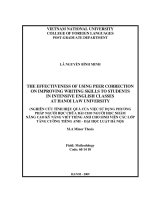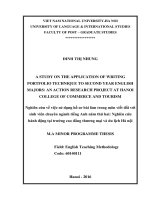Ielts writing task 1line graph sample
Bạn đang xem bản rút gọn của tài liệu. Xem và tải ngay bản đầy đủ của tài liệu tại đây (289.24 KB, 7 trang )
LINE GRAPH
(1) The line graph shows the percentage of Internet users in Canada,
Mexico and the USA from 1999 to 2009
The line graph compares the percentage of people using the Internet in three
nations between 1999 and 2009.
From an overall perspective, it is evident that the proportion of residents who
used the Internet showed an upward trend in each country. In addition, Canada
had the highest data over the years shown.
In 1999, the percentage of people using the Internet in the USA accounted for
the highest, at precisely 20%. The figures for Canada and Mexico were much
lower, at exactly 10% and about 5%, respectively. The following 6 years
witnessed a dramatic increase in the percentages of Internet users in the USA
and Canada, reaching 70% in each country. A similar pattern could be seen in
the figure for Mexico that rose to exactly 30%.
In 2009, a surge in the percentage of citizens who used the Internet in Canada
was seen, reaching a peak of precisely 100%. Similarly, there was a steady
increase to 80% in the proportion of Internet users in the USA, higher than the
final figure for Mexico, at 40%.
(176 words)
(2) The line graph below shows the oil production and consumption in
China between 1982 and 2006.
The line chart illustrates the number of oil tanks produced and consumed per
day in China from 1982 to 2006.
From an overall perspective, it is evident that the number of oil barrels produced
and consumed in China experienced an upward trend. In addition, oil
consumption had the highest data over the years shown.
In 1982, the number of oil barrels consumed and produced was relatively the
same, at around 2 million barrels per day. The following 12 years witnessed an
increase in the number of oil barrels consumed, rising significantly to over 3
million. A similar pattern could be seen in the figure for oil production that
reached around 3 million.
In 2006, there was a surge in the number of oil barrels consumed per day,
reaching a peak of over 6 million. Similarly, the number of oil tanks produced per
day in China climbed gradually to about 3,5 million.
(159 words)
(3) The chart below shows the percentage of difference in income
between men and women from 1978 to 2008.
The line graph compares the income gap between genders in five different
nations between 1978 and 2008.
From an overall perspective, it is evident that the percentage of difference in
income between men and women in most of the countries experienced a
downward trend, except for Australia. In addition, Australia had the most
dramatic growth in the wage gap between genders.
In 1978, the percentage of difference in income between genders in Japan was
highest, at almost 50%. The figures for the US and the UK were lower, at around
35% and less than 30%, respectively, compared to just below 20% in France. The
income gap between men and women in Australia, however, accounted for the
lowest, at about 17%.
From 1978 onwards, there was a steady decline in the percentage of difference
in income between genders in Japan, dropping to over 40% in 2008. Similarly,
the income gap between genders in the US and UK both fell consistently to
approximately 28%, compared to around 17% in France. Meanwhile, a dramatic
increase in the income gap between men and women in Australia was seen,
reaching a peak of nearly 25%.
(192 words)
(4) The line chart shows average attendance at the cinema among
various age groups in the US from 2000 to 2011.
The line graph compares the percentage of people in four different age groups
going to the movie theater between 2000 and 2011.
From an overall perspective, it is evident that the percentage of people attending
the cinema of four age groups experienced an upward trend. In addition, the 1524 age group had the highest data over the years shown.
In 1984, the proportion of theater customers aged 15-24 years old was highest, at
about 16%. The figures for people among 7-14 and 25-35 were lower, at precisely
10% and nearly 4%, respectively. The data on people aged 35 and over, however,
accounted for the lowest, at almost 0%.
After reaching a peak of almost 60% in 1999, the proportion of people aged 15-24
going to the cinema fell to nearly 54% in 2000. Meanwhile, an increase was seen
in the figures for those aged 7-14 and 25-35, reaching above 30% for each age
group in 2000. Similarly, the data on people from 35 and over significantly went
up to about 15% in the final year.
(177 words)
(5) The chart below gives information about car ownership in the
UK from 1975 to 2005 (percentage)
The line graph illustrates how car ownership in the UK changed between 1975
and 2005.
From an overall perspective, it is evident that the percentage of people owning
cars in the UK experienced an upward trend, whereas the opposite was true for
those having no cars. In addition, the percentage of people having one car was
highest over the years shown.
In 1975, the proportion of people owning one car was highest, at 45%. The figure
for those with no cars was slightly lower, at roughly 43%, compared to just above
5% of those owning two cars. Meanwhile, the percentage of those having three
cars accounted for the lowest, at about 3%.
In 2005, the proportion of residents having one car remained unchanged at 45%.
There was a significant decrease in the figure for people having no cars in the UK,
falling to about 23%. By contrast, the percentages of those owning two cars and
three cars in the UK climbed steadily to approximately 20% and 10%,
respectively.
(168 words)
(6) The graph below shows consumers’ average annual expenditures
on cell phone, national and international fixed-line and services in
America between 2001 and 2010.
The line chart compares the average amount of money spent annually on cell
phone services, and national and international fixed-line services in America from
2001 to 2010.
From an overall perspective, it is evident that the average annual expenditures on
cell phone services, and international fixed-line services in America experienced
an upward trend, whereas the opposite was true for national fixed-line services. In
addition, expenditures on cell phone services were highest over the years shown.
In 2001, the average annual expenditure on national fixed-line services was
highest, at 700 dollars, compared to about 250 dollars spent on international
fixed-line services. The spending on cell phone services accounted for the lowest,
at 200 dollars. The following five years witnessed a significant decrease of about
200 dollars in the average expenditure on national fixed-line services. Conversely,
the figures for mobile phone services and international fixed-line services rose to
500 dollars and 300 dollars, respectively.
In 2010, there was a surge in the figure for smartphone services, reaching a peak
of over 700 dollars. The figure for international fixed-line services remained
relatively identical, at roughly 300 dollars. Meanwhile, the spending on national
fixed-line services fell significantly to 400 dollars.
(196 words)








